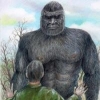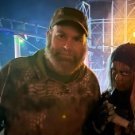I recently read Dustin Severs book The Abominable Snowman of California, and posted a short review in the link below.
https://bigfootforums.com/topic/79909-read-any-good-bigfoot-books-lately/?do=findComment&comment=1161047
It is an excellent book and I highly recommend it.
This post is on a couple of interesting observations that I learned from that book that could merit sharing here in BFF.
One is about the first Bigfoot footprint cast and the other is on the research methodology that Peter Byrne’s used at Bluff Creek in 1960.
On the First Bigfoot Footprint Cast
It appears that the 1958 Jerry Crew foot cast was the first cast made of a supposed bigfoot/sasquatch in North America. I was surprised that John Green and Rene Dahinden had not gotten any sasquatch track casts done in British Columbia, since they have been researching the Sasquatch claims over there since 1956 and the Harrison Springs area was known for sasquatch presence (or at least the town promoted that view). No wonder they got excited about the Crew find and John Green drove to Bluff Creek CA right away. But how come nobody in British Columbia was casting sasquatch tracks (real or fake?)
Also, it appears that nobody in Arkansas or in Florida was casting tracks of either Fouke Monster or Skunk Ape during the 1950’s. If that is the case, then Jerry Crew gets the credit for being the first person in North America to cast a bigfoot/sasquatch track. In the book, Severs shows a photo of Sanderson holding a plaster cast of a south Florida three-toed monster in 1948 (many years later determined to be a hoax). But Sanderson never claimed it was made by an ape but instead by a giant penguin-like creature. Nonetheless, that cast proves that there were people out there creating plaster casts of unknown footprints before 1958.
On Byrne’s Research Strategy
The other interesting bit of information that really impressed me was the way that Peter Byrne and his team conducted his field research around Bluff Creek in 1960 (as part of Slick’s Pacific Northwest Expedition). The story comes from a team member named Steve Matthes, who had retired from the US Fish & Wildlife Department and became a professional cougar hunter. Dustin Sever quotes from a book Matthes wrote in 1988 titled Brave and other Stories.
Matthes gives his opinion on Byrne’s research strategy at Bluff Creek as follows (Severs, page 300)
“Byrne was a good hunter and planned the hunt well”. The theory was that Bigfoot, being a humanoid, would search for food along and in streams, as would man. Peter and Bryan would start at one end of a stream and search it entire length while Jim and I would start at the head of another and check the sandbars for tracks”. By the end of that summer, they had “combed each drainage of any area leading into the Klamath River.”
But despite such earnest efforts, they never came across a single track.
Matthes found this more than suspect. “We thought it was damned strange that the only tracks to be found were right in plain sight,”, he wrote, “and never on places like sandbars where they should be if there were such an animal in that neck of the woods.”
I agree with Matthes and Severs that this was a red flag.
Byrne’s idea of searching in the Bluff Creek watershed and all the drainages into the Klamath River makes perfect sense and it must have been a lot of work. I never read Byrne’s books, so I do not know if he goes over his strategies and failures to get any tracks at Bluff Creek in 1960. Nonetheless, if he did what Matthes claims, then he was a better researcher than Dahinden and Green who mainly looked at tracks that were already found by others. This strategy appears very similar to what the Olympic Project has been doing, with a focus on watersheds and drainages.


